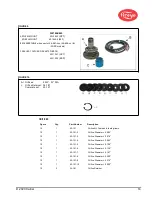
© 2020 Carrier
10
Temperature: 257°F (125°C), maximum O.D. 0.43" (10.9 mm)
Vibration specs:
Frequency range: 10 Hz – 150 Hz.
Acceleration / Amplitude: 58 to 150 Hz: 1.0 g / 10 to 58 Hz: 0.075g
Sweep rate: 1 octave per minute
Number of sweep cycles: 10
Number of axes: 3, mutually perpendicular
Note: Wiring is SELV for Input (24V DC) only, and is non-SELV for the other connections.
INSTALLATION NOTES
The InSight Series 4 flame scanners determine the presence or absence of flame by monitoring the
frequency spectrum of the flame. The scanner should initially be mounted so that the primary
combustion zone is within the scanner’s line of sight.
The location and sighting instructions listed in the following sections are rough guidelines for the
location of the scanner. The scanner provides feedback via its OLED display to assist in the adjustment
and proper alignment of the flame scanner. Refer to the setpoint procedures described in this bulletin.
Note: An acceptable scanner location must ensure the following:
Reliable main flame and/or ignitor flame detection at all air flow and furnace loads (ranges of fuel
firing).
Rejection of the ignitor flame if too short, or in the wrong position to ignite the main flame reliably,
thus prohibiting the delivery of fuel to the burner.
INSTALLATION PROCEDURE
WARNING: Protective filtered lenses should be worn when viewing flame. Infrared and
ultraviolet energy from the flame can be damaging to the eyes.
1.
The best results are obtained when the scanner is aimed so that the scanner’s line of sight inter-
sects the burner center at a slight angle (e.g. 5 degrees) and sees a maximum of the primary com-
bustion zone, as shown in Figure 3. If only one scanner is used per burner, the line of sight should
also intersect the igniting flame.
2. For installations where separate scanners are used to monitor main and ignitor flames, the main
flame scanner should be sighted so it does not detect the ignitor flame.
3.
The scanner should have an unrestricted view of flame as far as possible. Physical obstructions
such as air register blades, interfering vanes, or other hardware should be cut away or notched so
they do not fall within the scanner’s line of sight as shown in Figure 5.
Note: Always check with the burner manufacturer before you trim the register blades.
FIGURE 3.
SINGLE BURNER SCANNER SIGHTING
Summary of Contents for InSight 4 Series
Page 19: ... 2020 Carrier 19 Figure 14 WIRING DIAGRAM 95UVS4 1 95IRS4 1 with 59 547 cable ...
Page 27: ... 2020 Carrier 27 THE MAIN STATUS MENU FIGURE 20 MAIN STATUS MENU LOOP ...
Page 36: ... 2020 Carrier 36 THE CONFIG MENU FIGURE 23 CONFIG MENU LOOP ...
Page 40: ... 2020 Carrier 40 THE AUTO CONFIG MENU FIGURE 25 AUTO CONFIG MENU LOOP ...
Page 43: ... 2020 Carrier 43 THE FILE COPY MENU FIGURE 26 FILE COPY MENU LOOP ...
Page 45: ... 2020 Carrier 45 THE 4 20 mA MENU FIGURE 27 4 20mA MENU LOOP ...
Page 47: ... 2020 Carrier 47 THE DATE TIME MENU FIGURE 28 DATE TIME MENU LOOP ...
Page 49: ... 2020 Carrier 49 THE COMMS MENU FIGURE 29 COMMS MENU ...
Page 51: ... 2020 Carrier 51 THE MANUAL CONFIG MENUS FIGURE 30 ...
Page 52: ... 2020 Carrier 52 MANUAL CONFIG MENUS continued FIGURE 31 ...











































